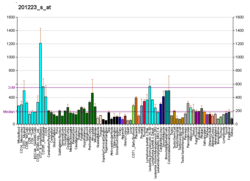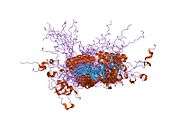RAD23B
UV excision repair protein RAD23 homolog B is a protein that in humans is encoded by the RAD23B gene.[5][6]
Function
The protein encoded by this gene is one of two human homologs of Saccharomyces cerevisiae Rad23, a protein involved in nucleotide excision repair (NER). This protein was found to be a component of the protein complex that specifically complements the NER defect of xeroderma pigmentosum group C (XP-c) cell extracts in vitro. This protein was also shown to interact with, and elevate the nucleotide excision activity of 3-methyladenine-DNA glycosylase (MPG), which suggested a role in DNA damage recognition in base excision repair. This protein contains an N-terminal ubiquitin-like domain, which was reported to interact with 26S proteasome, and thus this protein may be involved in the ubiquitin mediated proteolytic pathway in cells.[7]
Role in DNA repair
The complex of XPC-RAD23B is the initial damage recognition factor in global genomic nucleotide excision repair (GG-NER). XPC-RAD23B recognizes a wide variety of lesions that thermodynamically destabilize DNA duplexes, including UV-induced photoproducts (cyclopyrimidine dimers and 6-4 photoproducts ), adducts formed by environmental mutagens such as benzo[a]pyrene or various aromatic amines, certain oxidative endogenous lesions such as cyclopurines and adducts formed by cancer chemotherapeutic drugs such as cisplatin. The presence of XPC-RAD23B is required for assembly of the other core NER factors and progression through the NER pathway both in vitro and in vivo.[8] Although most studies have been performed with XPC-RAD23B, it is part of a trimeric complex with centrin-2, a calcium-binding protein of the calmodulin family.[8]
Epigenetic repression
The protein expression level of RAD23B can be epigenetically repressed, either by promoter methylation of the RAD23B gene[9][10] or by either of two microRNAs (miR-744-3p[11] or miR-373[12]).
Deficiency of RAD23B in cancer
A deficiency in expression of a DNA repair gene increases the risk for cancer (see Deficient DNA repair in carcinogenesis). The expression of RAD23B is reduced in tumor tissue of women with breast cancer.[13] A low percentage of RAD23B positive nuclei in high grade breast cancer was also observed.[14]
RAD23B was substantially reduced by promoter methylation in a cell line derived from multiple myeloma.[9] and reduced by promoter methylation in a small proportion of non-small cell lung cancer (NSCLC) tumours.[10]
RAD23B appears to be one of 26 DNA repair genes that are epigenetically repressed in various cancers (see Cancer epigenetics).
Interactions
RAD23B has been shown to interact with PSMD4[15] and Ataxin 3.[16]
References
- 1 2 3 GRCh38: Ensembl release 89: ENSG00000119318 - Ensembl, May 2017
- 1 2 3 GRCm38: Ensembl release 89: ENSMUSG00000028426 - Ensembl, May 2017
- ↑ "Human PubMed Reference:".
- ↑ "Mouse PubMed Reference:".
- ↑ van der Spek PJ, Smit EM, Beverloo HB, Sugasawa K, Masutani C, Hanaoka F, Hoeijmakers JH, Hagemeijer A (Oct 1994). "Chromosomal localization of three repair genes: the xeroderma pigmentosum group C gene and two human homologs of yeast RAD23". Genomics. 23 (3): 651–8. doi:10.1006/geno.1994.1554. PMID 7851894.
- ↑ Masutani C, Sugasawa K, Yanagisawa J, Sonoyama T, Ui M, Enomoto T, Takio K, Tanaka K, van der Spek PJ, Bootsma D (Apr 1994). "Purification and cloning of a nucleotide excision repair complex involving the xeroderma pigmentosum group C protein and a human homologue of yeast RAD23". The EMBO Journal. 13 (8): 1831–43. PMC 395023. PMID 8168482.
- ↑ "Entrez Gene: RAD23B RAD23 homolog B (S. cerevisiae)".
- 1 2 Schärer OD (Oct 2013). "Nucleotide excision repair in eukaryotes". Cold Spring Harbor Perspectives in Biology. 5 (10): a012609. doi:10.1101/cshperspect.a012609. PMC 3783044. PMID 24086042.
- 1 2 Peng B, Hodge DR, Thomas SB, Cherry JM, Munroe DJ, Pompeia C, Xiao W, Farrar WL (Feb 2005). "Epigenetic silencing of the human nucleotide excision repair gene, hHR23B, in interleukin-6-responsive multiple myeloma KAS-6/1 cells". The Journal of Biological Chemistry. 280 (6): 4182–7. doi:10.1074/jbc.M412566200. PMID 15550378.
- 1 2 Do H, Wong NC, Murone C, John T, Solomon B, Mitchell PL, Dobrovic A (2014). "A critical re-assessment of DNA repair gene promoter methylation in non-small cell lung carcinoma". Scientific Reports. 4: 4186. doi:10.1038/srep04186. PMC 3935198. PMID 24569633.
- ↑ Hatano K, Kumar B, Zhang Y, Coulter JB, Hedayati M, Mears B, Ni X, Kudrolli TA, Chowdhury WH, Rodriguez R, DeWeese TL, Lupold SE (Apr 2015). "A functional screen identifies miRNAs that inhibit DNA repair and sensitize prostate cancer cells to ionizing radiation". Nucleic Acids Research. 43 (8): 4075–86. doi:10.1093/nar/gkv273. PMC 4417178. PMID 25845598.
- ↑ Crosby ME, Kulshreshtha R, Ivan M, Glazer PM (Feb 2009). "MicroRNA regulation of DNA repair gene expression in hypoxic stress". Cancer Research. 69 (3): 1221–9. doi:10.1158/0008-5472.CAN-08-2516. PMC 2997438. PMID 19141645.
- ↑ Matta J, Morales L, Dutil J, Bayona M, Alvarez C, Suarez E (Feb 2013). "Differential expression of DNA repair genes in Hispanic women with breast cancer". Molecular Cancer Biology. 1 (1): 54. doi:10.9777/mcb.2013.10006. PMC 4189824. PMID 25309843.
- ↑ Linge A, Maurya P, Friedrich K, Baretton GB, Kelly S, Henry M, Clynes M, Larkin A, Meleady P (Jul 2014). "Identification and functional validation of RAD23B as a potential protein in human breast cancer progression". Journal of Proteome Research. 13 (7): 3212–22. doi:10.1021/pr4012156. PMID 24897598.
- ↑ Hiyama H, Yokoi M, Masutani C, Sugasawa K, Maekawa T, Tanaka K, Hoeijmakers JH, Hanaoka F (Sep 1999). "Interaction of hHR23 with S5a. The ubiquitin-like domain of hHR23 mediates interaction with S5a subunit of 26 S proteasome". The Journal of Biological Chemistry. 274 (39): 28019–25. doi:10.1074/jbc.274.39.28019. PMID 10488153.
- ↑ Wang G, Sawai N, Kotliarova S, Kanazawa I, Nukina N (Jul 2000). "Ataxin-3, the MJD1 gene product, interacts with the two human homologs of yeast DNA repair protein RAD23, HHR23A and HHR23B". Human Molecular Genetics. 9 (12): 1795–803. doi:10.1093/hmg/9.12.1795. PMID 10915768.
Further reading
- Maruyama K, Sugano S (Jan 1994). "Oligo-capping: a simple method to replace the cap structure of eukaryotic mRNAs with oligoribonucleotides". Gene. 138 (1–2): 171–4. doi:10.1016/0378-1119(94)90802-8. PMID 8125298.
- van der Spek PJ, Eker A, Rademakers S, Visser C, Sugasawa K, Masutani C, Hanaoka F, Bootsma D, Hoeijmakers JH (Jul 1996). "XPC and human homologs of RAD23: intracellular localization and relationship to other nucleotide excision repair complexes". Nucleic Acids Research. 24 (13): 2551–9. doi:10.1093/nar/24.13.2551. PMC 145966. PMID 8692695.
- Suzuki Y, Yoshitomo-Nakagawa K, Maruyama K, Suyama A, Sugano S (Oct 1997). "Construction and characterization of a full length-enriched and a 5'-end-enriched cDNA library". Gene. 200 (1–2): 149–56. doi:10.1016/S0378-1119(97)00411-3. PMID 9373149.
- Sugasawa K, Ng JM, Masutani C, Iwai S, van der Spek PJ, Eker AP, Hanaoka F, Bootsma D, Hoeijmakers JH (Aug 1998). "Xeroderma pigmentosum group C protein complex is the initiator of global genome nucleotide excision repair". Molecular Cell. 2 (2): 223–32. doi:10.1016/S1097-2765(00)80132-X. PMID 9734359.
- Hiyama H, Yokoi M, Masutani C, Sugasawa K, Maekawa T, Tanaka K, Hoeijmakers JH, Hanaoka F (Sep 1999). "Interaction of hHR23 with S5a. The ubiquitin-like domain of hHR23 mediates interaction with S5a subunit of 26 S proteasome". The Journal of Biological Chemistry. 274 (39): 28019–25. doi:10.1074/jbc.274.39.28019. PMID 10488153.
- Miao F, Bouziane M, Dammann R, Masutani C, Hanaoka F, Pfeifer G, O'Connor TR (Sep 2000). "3-Methyladenine-DNA glycosylase (MPG protein) interacts with human RAD23 proteins". The Journal of Biological Chemistry. 275 (37): 28433–8. doi:10.1074/jbc.M001064200. PMID 10854423.
- Wang G, Sawai N, Kotliarova S, Kanazawa I, Nukina N (Jul 2000). "Ataxin-3, the MJD1 gene product, interacts with the two human homologs of yeast DNA repair protein RAD23, HHR23A and HHR23B". Human Molecular Genetics. 9 (12): 1795–803. doi:10.1093/hmg/9.12.1795. PMID 10915768.
- Araújo SJ, Nigg EA, Wood RD (Apr 2001). "Strong functional interactions of TFIIH with XPC and XPG in human DNA nucleotide excision repair, without a preassembled repairosome". Molecular and Cellular Biology. 21 (7): 2281–91. doi:10.1128/MCB.21.7.2281-2291.2001. PMC 86862. PMID 11259578.
- Araki M, Masutani C, Takemura M, Uchida A, Sugasawa K, Kondoh J, Ohkuma Y, Hanaoka F (Jun 2001). "Centrosome protein centrin 2/caltractin 1 is part of the xeroderma pigmentosum group C complex that initiates global genome nucleotide excision repair". The Journal of Biological Chemistry. 276 (22): 18665–72. doi:10.1074/jbc.M100855200. PMID 11279143.
- Park H, Suzuki T, Lennarz WJ (Sep 2001). "Identification of proteins that interact with mammalian peptide:N-glycanase and implicate this hydrolase in the proteasome-dependent pathway for protein degradation". Proceedings of the National Academy of Sciences of the United States of America. 98 (20): 11163–8. doi:10.1073/pnas.201393498. PMC 58701. PMID 11562482.
- Walters KJ, Kleijnen MF, Goh AM, Wagner G, Howley PM (Feb 2002). "Structural studies of the interaction between ubiquitin family proteins and proteasome subunit S5a". Biochemistry. 41 (6): 1767–77. doi:10.1021/bi011892y. PMID 11827521.
- Lee SM, Li ML, Tse YC, Leung SC, Lee MM, Tsui SK, Fung KP, Lee CY, Waye MM (Sep 2002). "Paeoniae Radix, a Chinese herbal extract, inhibit hepatoma cells growth by inducing apoptosis in a p53 independent pathway". Life Sciences. 71 (19): 2267–77. doi:10.1016/S0024-3205(02)01962-8. PMID 12215374.
- Shimizu Y, Iwai S, Hanaoka F, Sugasawa K (Jan 2003). "Xeroderma pigmentosum group C protein interacts physically and functionally with thymine DNA glycosylase". The EMBO Journal. 22 (1): 164–73. doi:10.1093/emboj/cdg016. PMC 140069. PMID 12505994.
- Ng JM, Vermeulen W, van der Horst GT, Bergink S, Sugasawa K, Vrieling H, Hoeijmakers JH (Jul 2003). "A novel regulation mechanism of DNA repair by damage-induced and RAD23-dependent stabilization of xeroderma pigmentosum group C protein". Genes & Development. 17 (13): 1630–45. doi:10.1101/gad.260003. PMC 196135. PMID 12815074.
- Ryu KS, Lee KJ, Bae SH, Kim BK, Kim KA, Choi BS (Sep 2003). "Binding surface mapping of intra- and interdomain interactions among hHR23B, ubiquitin, and polyubiquitin binding site 2 of S5a". The Journal of Biological Chemistry. 278 (38): 36621–7. doi:10.1074/jbc.M304628200. PMID 12832454.
- Fujiwara K, Tenno T, Sugasawa K, Jee JG, Ohki I, Kojima C, Tochio H, Hiroaki H, Hanaoka F, Shirakawa M (Feb 2004). "Structure of the ubiquitin-interacting motif of S5a bound to the ubiquitin-like domain of HR23B". The Journal of Biological Chemistry. 279 (6): 4760–7. doi:10.1074/jbc.M309448200. PMID 14585839.
- Glockzin S, Ogi FX, Hengstermann A, Scheffner M, Blattner C (Dec 2003). "Involvement of the DNA repair protein hHR23 in p53 degradation". Molecular and Cellular Biology. 23 (24): 8960–9. doi:10.1128/MCB.23.24.8960-8969.2003. PMC 309646. PMID 14645509.












